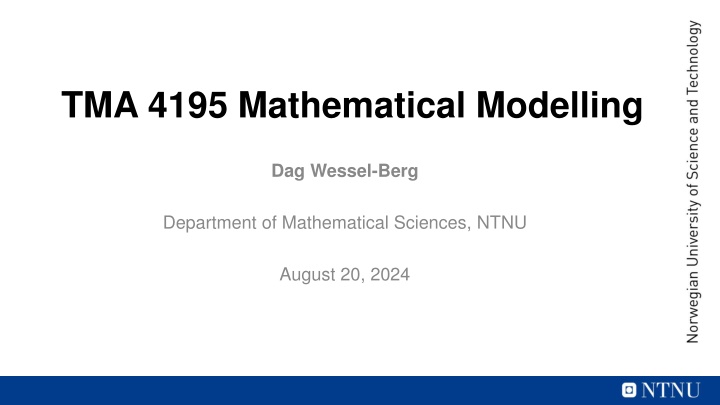
Mathematical Modelling Course at NTNU - Overview and Details
Explore the Mathematical Modelling course at NTNU focusing on dimensional analysis, stability analysis, perturbation analysis, and more. Learn about projects, course content, and what you need to know in advance. Dive into the art of mathematical modelling for practical problem-solving.
Download Presentation

Please find below an Image/Link to download the presentation.
The content on the website is provided AS IS for your information and personal use only. It may not be sold, licensed, or shared on other websites without obtaining consent from the author. If you encounter any issues during the download, it is possible that the publisher has removed the file from their server.
You are allowed to download the files provided on this website for personal or commercial use, subject to the condition that they are used lawfully. All files are the property of their respective owners.
The content on the website is provided AS IS for your information and personal use only. It may not be sold, licensed, or shared on other websites without obtaining consent from the author.
E N D
Presentation Transcript
TMA 4195 Mathematical Modelling Dag Wessel-Berg Department of Mathematical Sciences, NTNU August 20, 2024
Lectures and exercise class Lectures Mondays 0815-1000 R9 Tuesdays 0815-1000 G1 Exercise class My office 1050, 10.floor, Sentralbygg 2, Mondays 1015-110 Or actually, you are of course welcome anytime! 2
Course information Home page:wiki.math.ntnu.no/tma4195/2024h/start The application Blackboard not used All relevant information is supposed to be on the wiki home page Grading: Final exam (75%) and project (25%). Literature: See wiki page Exercises: Are not mandatory but strongly recommended. Project: Week 44-46, group work. 3
Course content 1 Dimensional analysis Simple mathematical models. Reduction of the number of variables. 2 Scaling Equations on dimensionless form Identification of important and negligible quantities. And lots of exiting examples from a variety of topics! 3 Perturbation analysis, regular and singular Approximation of equations and solutions of equations with small/large coefficients. 4 Stability analysis Stability of equilibrium points. Bifurcations 5 Specific methods and models, hyperbolic conservation laws. Conservation laws, Reynold s transport theorem Method of characteristics, traffic modelling, flow in porous media and other models 4
Project, last three weeks Topic: To be announced Work in groups of 4 to 5 students Deliver a written report, approximately ten pages. Last year s topic: Modelling of litium-ion batteries 5
What you need to know in advance Solve separable differential equations Solve 1.order linear differential equations Solve 2.order linear equations with constant coefficients, both homogeneous and inhomogeneous. Linear algebra, including eigenvalues and eigenvectors Some vector analysis, in particular surface integrals and the divergence theorem. 6
Mathematical modelling in general . . . can be roughly described as the art of translating practical problems into mathematical formulations, and using these formulations together with theoretical and numerical methods to obtain further insight into the problem and shed light on concrete practical questions. Typical procedure: 1 2 3 4 5 6 Identification of the problem and the relevant quantities involved. Formulation of relation(s) between these quantities. Simplification and model reduction. Theoretical analysis and/or numerical approximation. Comparison of the results with real data. Revision and refinement of the model 7
Dimensional Analysis Can testing small models tell us anything about large models? Why are ants so strong ?
Detonation of the first atomic bomb What is the released energy? 10
